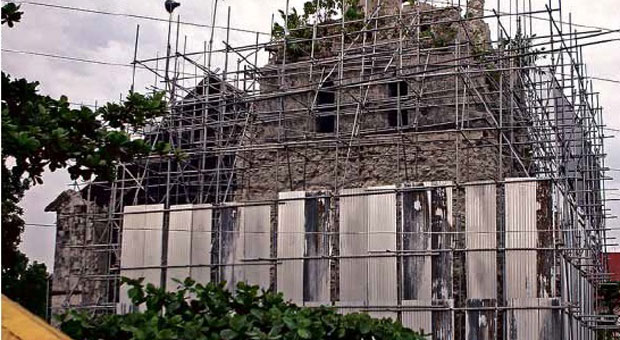Government funds restoration of churches

RISING FROM THE RUINS Baclayon Church, located 6 kilometers away from Tagbilaran City, is undergoing major repairs after being damaged by the 7.2-magnitude quake that struck Bohol province last year. LITO TECSON/ CEBU DAILY NEWS
(Second of three parts)
TAGBILARAN CITY, Philippines—In the days immediately following the earthquake, Malacañang initially balked at the notion of government assistance for these heritage structures, citing the doctrine of Church and State separation enshrined in the Constitution.
Malacañang relented when informed of existing laws like Republic Act No. 10066, or the National Cultural Heritage Law, which empowers the State to come to the aid of registered or marked historic structures or cultural treasures.
Two months later, on Dec. 27, 2013, Budget Secretary Butch Abad visited Bohol province and announced a belated Christmas present: P650 million was in the national budget for these structures plus one in Samar province, the church of Guiuan town that was damaged during Super Typhoon “Yolanda” (international name: Haiyan), which wreaked havoc on parts of the Visayas on Nov. 8, just three weeks after the earthquake.
Three months later, on March 28, a quadripartite agreement was signed between the National Commission for Culture and the Arts (NCCA), the National Museum (NM), the National Historical Commission of the Philippines (NHCP) and the Tourism Infrastructure and Enterprise Zone Authority, with the latter serving as conduit for funds to the NM and NHCP in a national calamity-related heritage reconstruction and restoration program (NHRRP).
The NCCA was given P10 million out of the initial P650 million to prepare for a series of experts’ conferences while the NM and the NHCP divided the rest.
3 work phases
According to the agreement, the NHRRP would be implemented in three phases.
Phase 1, costing P150 million, covers prerestoration work, which already includes the retrieval sand documentation work started by the NM and the NHCP within days of the earthquake and up until clearing operations would be finished.
Also included are the conduct of 3D scanning, detailed engineering studies (DES) and geological studies, as well as the shoring and support of unstable structures and the construction of temporary storage facilities.
Phase 2 begins with a series of experts’ conferences intended to formulate a master plan for heritage restoration or reconstruction and specific plans for each structure to be restored or reconstructed. This is contingent on the completion of Phase I and was originally scheduled for May 2014 but has now been moved to November 2014.
The delay is due in part to the difficulty of vetting private contracting firms that could carry out 3D laser scanning and/or DES, given the huge number of structures to be scanned and studied not only Bohol but also Cebu province.
Phase 2 also covers stakeholders’ meetings, where all the plans will be presented for their comment.
Actual restoration
Phase 3, originally scheduled for implementation between September 2014 and the end of 2017, involves the actual restoration or reconstruction of churches that have either been declared by the NM as national cultural treasures (NCTs) or important cultural properties (ICPs), or by the NHCP as national historical landmarks (NHLs).
Sixteen of these are in Bohol while eight are in Cebu and one is in Samar (the church of Guiuan). All these are not just churches but also include Spanish-era watchtowers found on small islands or coastal towns in Bohol (like that of Pamilacan Island).
It is in this phase where the original conservation management plans carried out by Melva Rodriguez-Java of Cebu Archdiocesan Commission for the Cultural Heritage of the Church on some of the churches in Bohol and Cebu way before the tremor took its toll will come in handy.
With a team of architecture students from the University of San Carlos and with funding from the NCCA, Java and her students had already completed documenting the architecture of a number of churches, including those of Baclayon, Dauis and Dimiao in Bohol, Boljoon, Dalaguete and Sibonga in Cebu.
An important element in the quadripartite agreement is the provision that empowers the NM and the NHCP to add to the coverage of the NHRRP those structures originally listed as NCTs, ICPs or NHLs at the time of the earthquake or Yolanda. In Cebu, for example, the churches of Dumanjug and Samboan have been added by the NHCP.
Wider coverage
An interesting part of the agreement is the clear delineation of responsibility between the two cultural agencies that often have markers on each particular church.
The NM, which, under Jeremy Barns, has marked many churches in Bohol either as NCTs or ICPs, will be responsible for the churches of Albruquerque, Cortes, Dimiao, Loon, Maribojoc and Pangalo in Bohol, as well as the church of Guiuan in Samar. Also under the NM are the old Provincial Capitol building and the watchtowers of Balilihan, Loay, Punta Cruz and Panglao in Bohol.
Under the care of the NHCP, on the other hand, are the churches of Baclayon and Dauis in Bohol, as well as Basilica del Sto. Niño, Cebu Metropolitan Cathedral and the churches of Carcar, Dalaguete and Sibonga, together with the Museo Sugbo complex, Magellan’s Cross Pavilion and Fort San Pedro, in Cebu.
The solitary watchtower on Pamilacan was also placed under the NHCP’s care. The churches of Bantayan, Dumanjug and Samboan, and the watchtower of Malabuyoc, all in Cebu, as well as that of the church of Inabanga in Bohol were also added after the agreement.
(Editor’s Note: Jobers Reynes Bersales is the author of the book “Pagsulay: Churches of Bohol Before and After the Earthquake of 2013,” which was launched recently. He heads the University of San Carlos Press and teaches heritage courses at the university.)
FIRST PART
Not all damaged churches can be restored














